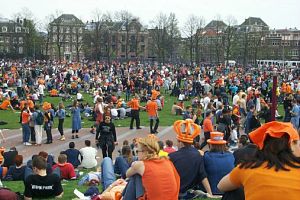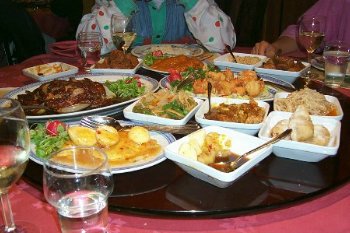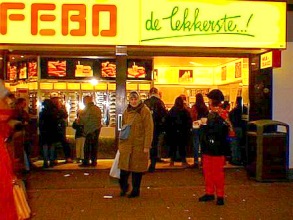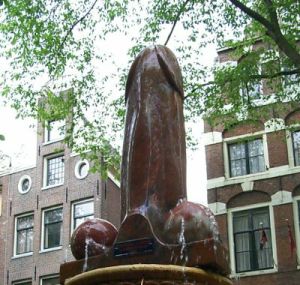| #1 – Inner Harbor – Canal Boat Tours | #2 – Beurs van Berlage – Museum & Concert Hall |
| #3 – Oude Kerk – Museum & Exhibits | #4 – Dam Square War Memorial |
| #5 – Red Light District | #6 – Greenhouse Centrum |
| #7 Cannabis College and Hash Hemp Marijauna Museum and | #8 – Extase Coffee Shop |
| #9 – Nieuwmarkt | #10 – City Hall & Music Theater |
| #11 – Bluebird Coffee Shop | #12 – Waterlooplein – Open Air Shopping |
| #13 – Greenhouse Namaste | #14 – Jewish Historical Museum |
| #15 – Hortus Botanicus – Gardens |
Category Archives: Hip Guide to Amsterdam
Koninginnedag (Queen’s Day)

No, this isn’t a gay festival, it’s the celebration of the Queen of Holland’s birthday on April 30th. Her birthday actually falls on a different day, but who cares? This is the biggest party day of the year as the whole country wears orange, goes nuts and gets very drunk. They say two million people fill the streets of Amsterdam, making it impossible to get around. You’d be amazed to see what transpires. Amsterdam is one big party and the debris takes days for huge crews to clean up the ankle deep trash. Holland also turns into a big flea market as this is the one day of the year when every Dutchman, woman and child cleans out their junk and places it on the street for everyone to see and buy (hopefully). What a scene!
Guess what? They also celebrate Queen’s Day in Canada!
Where to Find Restaurants in Amsterdam
The largest concentration of restaurants in Amsterdam is around the Leidseplein. In the summer, almost all have outdoor seating. This is most enjoyable since you get to people watch, musicians come around to serenade you, and you can more easily avoid smokers (often a problem as few Dutch restaurants have non-smoking sections). Here there are streets leading away from the square with one restaurant after another. The competition is intense, and after you’ve spent ten minutes trying to decide which one to eat at, they all start looking the same. It’s a good idea to decide what type of food you want which will make choosing somewhat easier. You might want to decide based upon ambiance, but if you’re eating outdoors, they’re all equal.
The Leidseplein area has a number of well known restaurants including ‘t Swarte Schaep (The Black Sheep) with great food in a cozy 300 year old building (expensive). We found several very good, reliable Italian restaurants in the area, and some not so good Indian restaurants. The best clue as to how good the food is, is how long the line is!
Amsterdam’s Restaurant Scene
Dining in Amsterdam can range from fast food to world class cuisine. Dutch food tends to be very hardy but heavy and unimaginitive, relying upon meats, fish, foul and starches for main courses. Ethnic cuisine is much more varied, and centuries of immigrants have added their flavors to the available palate. Foremost among these is Indonesian Food, with the rice table a most elegant affair (photo).
 There are countless Indonesian restaurants in town serving up Gado Gado, satay, spicy sambals, crispy krupek, nasi goreng, etc. This is a real treat since only Indonesia has more authentic restaurants. You’ll find lots of Chinese restaurants in town, but be wary. If you’re used to real Chinese food or even Americanized Chinese, you might be disappointed because this is Chinese food, Indonesian style. Many people of Chinese decent have emigrated from Indonesia to Holland bringing their style of cooking. Fortunately there are a few real Chinese restaurants in Amsterdam. These are clustered in the Red Light District in Amsterdam’s Chinatown. You can spot these restaurants since they have cooked ducks hanging in the windows. Our favorite Chinese/Indonesian restaurant is the Oriental City (see photo), a two story restaurant with good views on the Oudezijdsvoorburgwal.
There are countless Indonesian restaurants in town serving up Gado Gado, satay, spicy sambals, crispy krupek, nasi goreng, etc. This is a real treat since only Indonesia has more authentic restaurants. You’ll find lots of Chinese restaurants in town, but be wary. If you’re used to real Chinese food or even Americanized Chinese, you might be disappointed because this is Chinese food, Indonesian style. Many people of Chinese decent have emigrated from Indonesia to Holland bringing their style of cooking. Fortunately there are a few real Chinese restaurants in Amsterdam. These are clustered in the Red Light District in Amsterdam’s Chinatown. You can spot these restaurants since they have cooked ducks hanging in the windows. Our favorite Chinese/Indonesian restaurant is the Oriental City (see photo), a two story restaurant with good views on the Oudezijdsvoorburgwal.
Fast Food
 Just like the old Horn and Hardart automats in New York, at the Febo, food is placed in little self-serve compartments. Good for fresh patat frites (french fries), but you’re taking your chances with anything else. Another popular fast food chain in Amsterdam is New York City Pizza. With a variety of toppings they’re OK for a fast snack, but be wary in off hours, sometimes the pizza can sit around for hours, and they have to reheat it which hardly adds to the flavor.
Just like the old Horn and Hardart automats in New York, at the Febo, food is placed in little self-serve compartments. Good for fresh patat frites (french fries), but you’re taking your chances with anything else. Another popular fast food chain in Amsterdam is New York City Pizza. With a variety of toppings they’re OK for a fast snack, but be wary in off hours, sometimes the pizza can sit around for hours, and they have to reheat it which hardly adds to the flavor.
If you have the time, it’s far better to get a really good pizza at an Italian restaurant for around $5-$7. The most popular fast food is pomme frites, or what we call french fries. This is the cheapest, freshest, fast food around and it’s usually excellent. They offer a variety of sauces to put on it, including mayonaise, curry and ketchup. However the best are the Belgian type which are usually bigger with even more sauces available. These shops are few and usually have long lines.
Another good inexpensive meal is at any of the Sworma or Falafel places. Vegetarians can fill up on Falafel, salads, hummous and more while the meat eaters pig out on lamb. The Dutch will often snack on broodjes, sandwiches on rolls with cheese, meat, fish or salad. They don’t quite measure up to american sandwiches (we put lots more stuff on ours), but they’re good in a pinch.
Tolerance
The famous Dutch tolerance goes back at least to the Prince of Orange who defeated the Spanish in 1576 and drove them out of Holland. The Spanish Inquisition left deep scars upon the Dutch psyche and the Prince was keen to undo years of intolerance and abuse at the hands of the Spanish. Thus he declared that Holland would thereafter be a place where people could live their lives according to their own conscience and not be forced into one system or another. This attitude has persisted despite the attempts of the French (under Napoleon) and the Germans in the World Wars to impose their will upon the Dutch.
In the 1600s, Holland attracted many jews, protestants and others who fled their homelands in France, Germany, even England to practice their religion amongst the tolerant Dutch who welcomed them. One such group of people from England eventually decided to leave Holland for the new world. They left Leiden and when their ship had problems they stopped in England and hopped aboard a ship called the Mayflower. They later became known as the Pilgrims who founded the Plymouth colony in America.
Today Holland is a rare refuge in a world of conformity and intolerance. Home of the World Court, Greenpeace and other international organizations, Holland prides itself on it’s freedoms and relative sanity. Many of today’s persecuted minorities have found a warm welcome in Holland. These include gays, drug activists, political activists, etc. Every year the gay pride day in Amsterdam includes a flotilla of gaily decorated boats full of scantily clad gay men and women glorying in all the attention.
Amsterdam was the site of the last Gay Olympics which filled the city to capacity with hundreds of thousands of gay people and spectators. Few cities can match Amsterdam as a magnet for gays with dozens of gay bars, clubs, coffeeshops, etc. Likewise those who have been persecuted due to their attitude and activities regarding marijuana and hashish have found Holland to be close to heaven. Not only is soft drug use tolerated, it is a very profitable, growing industry with over 1000 coffeeshops dispensing marijuana on a daily basis. Menus list the various Dutch grown marijuana and imported hashish available for sale. One can sit back at an outdoor table and roll a joint or smoke a bong while passersby including the police, smile. This is the true test of a tolerant society. If someone is engaged in an activity, in public that harms no one, then there is no crime, no criminal and no problem! We can all learn from the Dutch how to get along and prosper as an open society.
The biggest challenge the Dutch face concerning tolerance is the integration of various ethnic groups into their society. Indonesians, Surinamese, Turks, Moroccans and others have been victims of intolerance and even hate crimes. However it seems as long as the Dutch economy prospers, the social unrest and prejudice is minimal. Efforts have been made in recent years to undo decades of economic and social discrimination against minority groups in Holland.
Smoking
This is just a warning to those Americans who come to Holland expecting a clean living, healthy society. Wrong! Like many European countries the Dutch are addicted to cigarettes and tobacco products. They have been very slow to inform their countrymen of the health dangers of smoking. The Dutch have never been known to be overprotective, and their historical trade in addictive substances (chocolate, tobacco, alcohol, marijuana, etc.) have made it hard for them to judge another person’s vices. But as the aging population succumbs to smoking related heart and lung diseases, the economic impact will surely be felt thanks to subsidized medicine.
In recent years the first anti-smoking campaigns have put billboards on the streets and hopefully their children are being discouraged from picking up the habit. However if you’re hoping to find a smoke free restaurant, cafe, pub or coffeeshop (haha, lots of marijuana AND tobacco smoke there), you’re outta luck! In the summer sitting outdoors can help (if you’re not downwind), but in poor weather, most places lack good ventilation, and you will probably inhale a cig or two with your beer or meal!
Recent studies have put Holland at or near the top in per capita tobacco consumption in Europe. Almost 40% of all Dutch adults smoke tobacco. The percentage among women has climbed dramatically in recent years. Economic and political pressure has made the Dutch very reluctant to fight tobacco companies because the tobacco tax revenues are a huge part of the national budget. But of course this will be outweighed when the entire society bears the economic brunt of millions of citizens dying early (hey, but then they get to save on pensions, no?).
Sex in Holland

Fountain in Red Light District
The Dutch have a much more liberal attitude towards sex than just about any other country. Sure there’s conservative small towns that don’t allow prostitution in their district, but by and large prostitution is an institution in Holland. That is, it is regulated and taxed like any industry. Workers are given regular health checks, they have a very vocal union, even pensions. The sex industry is huge in Holland, and they export many products including videos and sex toys. In the larger cities there are many sex supermarkets, some several stories tall. Videos, books and magazines run the gamut from straight and gay sex, S&M, to beastiality to child pornography (the last two are technically illegal, but readily available). If you can’t find what you’re looking for in one of these, it doesn’t exist! In addition these places also screen movies, have sex ‘cabins’ where you can view a movie and have sex, too. There are numerous private clubs that cater to every type of sexual fantasy or fetish. If you can’t get it off in Holland, you’ve really got a problem!
Amsterdam’s Red Light District is world famous for the number of prostitutes who cavort in front of windows in narrow alleyways and more busy streets. Red lights abound and some of the more popular ladies have a line outside. Fetish shops feature leather and studs with every kind of novelty item.
But your ordinary Dutchman is not impressed by all this as they’ve known all about sex since they were kids. In fact when kids reach the ripe age of 14, they are sometimes encouraged to have sex by their parents. It’s seen as something natural and healthy. In fact some disabled Dutchmen have been able to convince the government to increase their stipend to include the services of a sex worker once a month to ensure their health.
Sex can even be art in Holland. I’ve seen a show on TV on the KunstCanal (art channel) which consisted of an endless loop of a penis ejaculating. Nothing else, no bodies, no faces, just a penis. On public TV! How do you follow THAT act?
Like most northern European countries, the Dutch view sex and love as two very different things. Sex is something to be experienced spontaneously without expectations or hang-ups. Sexual relationships can coexist with loving ones. But that doesn’t rule out jealousy. Of course every society has its prudes, but in a place like Holland, they are a minority and often considered “country folk”.
Recreation
Probably the biggest form of recreation and exercise for the Dutch is bicycling through parks and countryside. The excellent network of bicycle paths (fietpads) can take you from any point to any other point in Holland, safely. I wonder if all this emphasis on bicycle riding besides being so healthy is also responsible for the Dutch being so tall. After all it does really stretch those legs!
Whether it’s on the thousands of canals, or out on lakes or the vast waterway in the north, Boating is very popular among the Dutch. Outings are big occasions and friends and family usually make a day of it. Even downtown Amsterdam’s canals turn into festive sights as boat after boat of merry makers pass under bridges waving at onlookers. Don’t miss an opportunity to join them! On the rare occasion when the canals are frozen, the Dutch take to the ice on skates.
When the weather allows, picnics are a popular pastime at Holland’s parks or beaches. These can be very elaborate with multi-course meals, champagne, even candelabra!
Movies are very popular in Holland and all are shown in the original language with Dutch subtitles, never dubbed. That’s another reason why the Dutch speak English and other languages so well.
The arts are alive and well in Holland thanks to a very advanced form of subscriptions that allow an infinite selection of shows, concerts, class, etc. Each year the UitMarkt is a weekend event that highlights the coming arts season with free performances of plays, music and other art previews.
Travel is something ingrained in the Dutch blood, from their days as the world’s greatest traders. They love to take vacations, especially during the bleak winters, to exotic destinations using the all-inclusive hotel package popular in Europe. For one price they get a room or apartment in say Turkey, Morocco, or Bali that includes meals. These deals can be great bargains, and it’s worth inquiring about if you plan an onward journey from Holland. Just stop in any travel agency and pickup the brochures to the destinations that interest you. It’s often much cheaper to book a trip in Holland than in the U.S. Of course independent travel is popular with young people and the Dutch get 4 to 6 weeks (paid vacation) off each year in which to explore the planet.
Dutch Politics
Holland is a monarchy, with Queen Beatrix as the sovereign head of state. The Dutch love the queen, perhaps more than the English love Queen Elisabeth. Recently there was an uproar among the Dutch because Crown Prince Willem decided to marry his sweetheart, an Argentinian. It’s well known that her father, a powerful minister in Argentina, may be partly responsible for thousands of missing people who disappeared when right wing death squads kidnapped left wing radicals after the fall of Salvadore Allende’s liberal government. To make matters worse, the whole royal family, including Queen Beatrix and her ailing husband attempted to explain their decision to allow the wedding to go forward, live on TV in front of the entire country. Not only don’t the Dutch approve of this marriage, but the whole royal family looked ridiculous trying to make sense of it!
Politics is a favorite topic of discussion in Holland. You can debate the latest laws, discuss scandals and politicians with any Dutchman, but be prepared, because they are very opinionated. It seems the Dutch spend far more time discussing the issues than doing anything about them. However when they do decide to take action it is in the widely acceptable form of open protest and demonstration. All it takes is a little organization and any cause can become a popular cause if it catches the current sentiment. However causes are like fads in Holland and what was popular one year becomes “old-fashioned” the next.
Holland has accepted its role as an International mediator by hosting the World Court in Den Haag. It also is home to GreenPeace and Friends of the Earth. Now with full participation in the EU, Holland is being pressured to conform in ways that are unusual for the Dutch.
The riot police crackdown during the EU Summit in Amsterdam in June 1997 was something never seen before in the Netherlands. 607 people were arrested (many more detained), foreigners deported, people denied due process, and the only damage was to a flower bed, a broken window and flags removed. An entire train full of 200 Italian protesters was not allowed to disembark (supposedly they damaged the train), and they were all sent back to Italy without any processing. This seems to be the new way to handle protests, beat ’em up, lock ’em up, send ’em home, and keep the media from seeing any of it. Sound familiar? Let’s hope the Dutch can retain their civility in the face of international pressure to become a police state. After all the English, Germans, French and especially the Americans have seen fit to interfere with the Netherlands’ sovereignty concerning their laws about drugs. So now it’s protests, what next? Can the Dutch tolerance survive this onslaught of Big Brother?
Update: Prince Willem Alexander married his Argentinian fiancee in a huge ceremony that paralyzed Amsterdam and the country for a day. It was done with all the pomp and ceremony tradition required, and it seems almost everyone loved it (an egg was tossed at the gilded carriage as they road thru the streets of Amsterdam!).


